Security and Privacy Reflection Report: Smart City Initiatives
VerifiedAdded on 2023/06/09
|16
|4482
|188
Report
AI Summary
This report explores the security and privacy implications of smart city initiatives, focusing on the implementation of smart sensors, Wi-Fi hotspots, and digital identity systems. It examines the potential impact of these technologies on citizens, including behavioral changes and privacy risks. The analysis covers ethical considerations, the potential for surveillance, and the vulnerability of personal data. The report discusses how the deployment of smart sensors can affect individuals' sense of privacy, the risks associated with public Wi-Fi, and the implications of digital identity systems. It also highlights the importance of security measures to protect personal information and mitigate potential misuse of data. The report concludes by emphasizing the need for a balanced approach that prioritizes both technological advancement and the protection of individual rights.
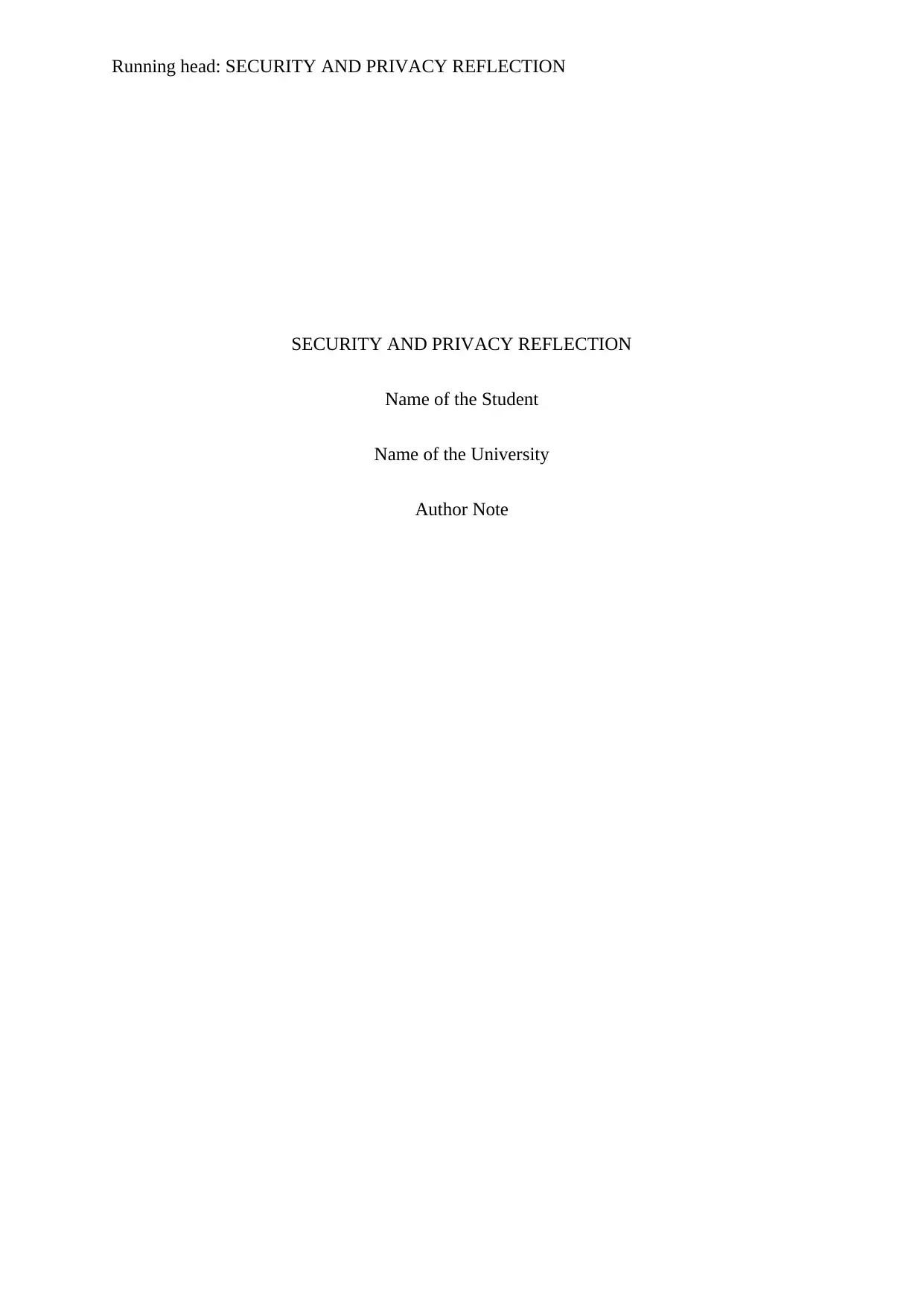
Running head: SECURITY AND PRIVACY REFLECTION
SECURITY AND PRIVACY REFLECTION
Name of the Student
Name of the University
Author Note
SECURITY AND PRIVACY REFLECTION
Name of the Student
Name of the University
Author Note
Secure Best Marks with AI Grader
Need help grading? Try our AI Grader for instant feedback on your assignments.
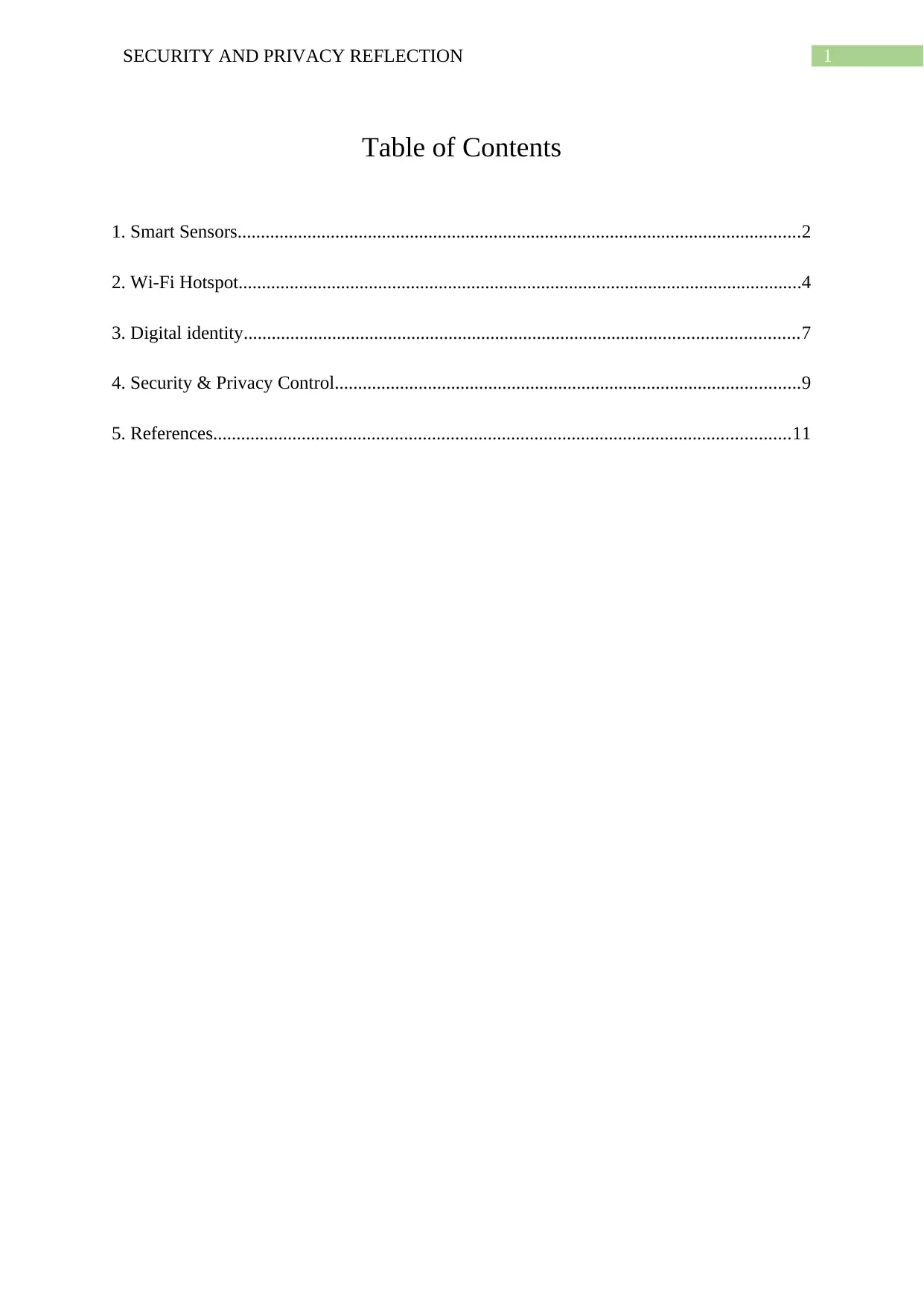
1SECURITY AND PRIVACY REFLECTION
Table of Contents
1. Smart Sensors.........................................................................................................................2
2. Wi-Fi Hotspot.........................................................................................................................4
3. Digital identity.......................................................................................................................7
4. Security & Privacy Control....................................................................................................9
5. References............................................................................................................................11
Table of Contents
1. Smart Sensors.........................................................................................................................2
2. Wi-Fi Hotspot.........................................................................................................................4
3. Digital identity.......................................................................................................................7
4. Security & Privacy Control....................................................................................................9
5. References............................................................................................................................11
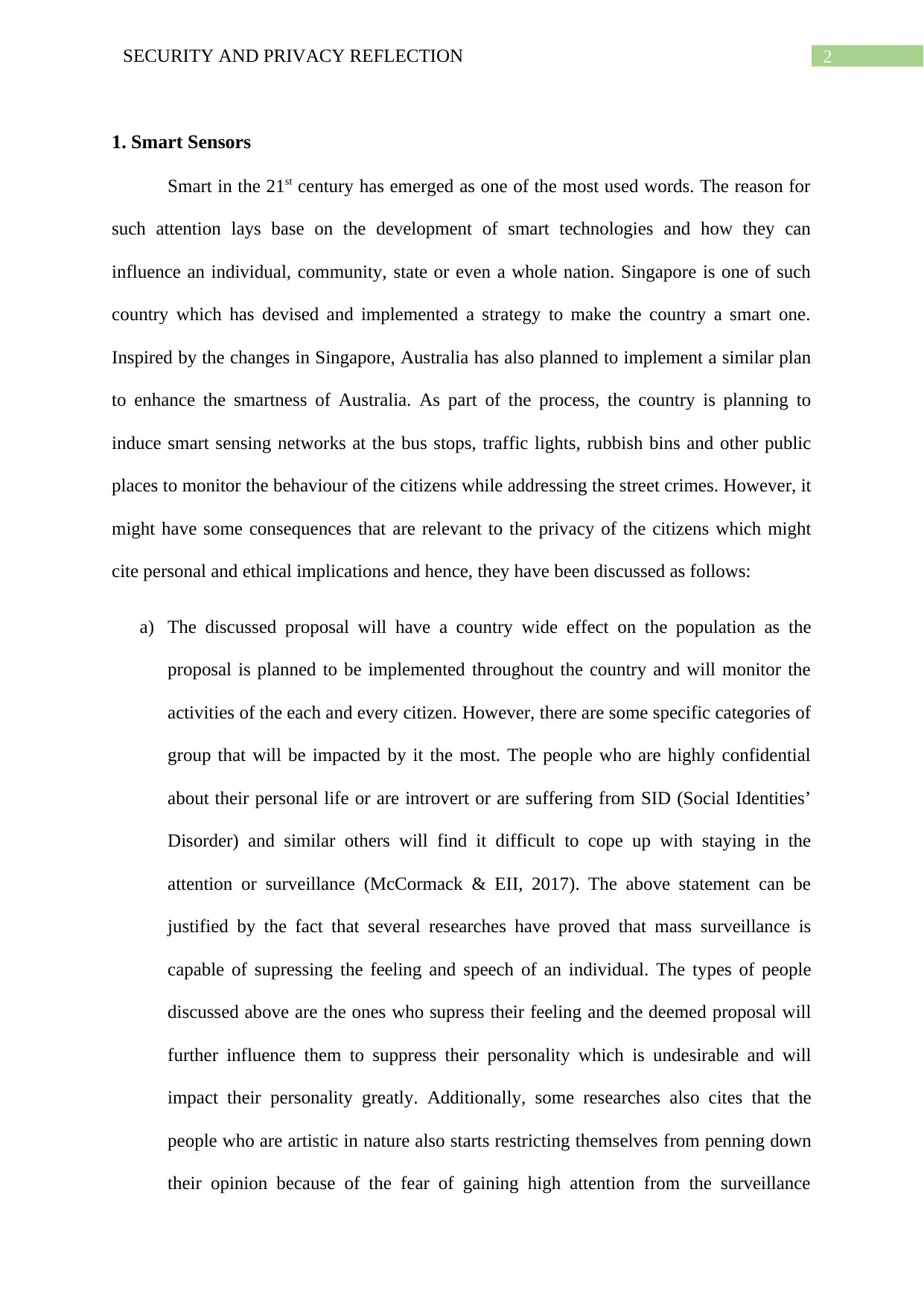
2SECURITY AND PRIVACY REFLECTION
1. Smart Sensors
Smart in the 21st century has emerged as one of the most used words. The reason for
such attention lays base on the development of smart technologies and how they can
influence an individual, community, state or even a whole nation. Singapore is one of such
country which has devised and implemented a strategy to make the country a smart one.
Inspired by the changes in Singapore, Australia has also planned to implement a similar plan
to enhance the smartness of Australia. As part of the process, the country is planning to
induce smart sensing networks at the bus stops, traffic lights, rubbish bins and other public
places to monitor the behaviour of the citizens while addressing the street crimes. However, it
might have some consequences that are relevant to the privacy of the citizens which might
cite personal and ethical implications and hence, they have been discussed as follows:
a) The discussed proposal will have a country wide effect on the population as the
proposal is planned to be implemented throughout the country and will monitor the
activities of the each and every citizen. However, there are some specific categories of
group that will be impacted by it the most. The people who are highly confidential
about their personal life or are introvert or are suffering from SID (Social Identities’
Disorder) and similar others will find it difficult to cope up with staying in the
attention or surveillance (McCormack & EII, 2017). The above statement can be
justified by the fact that several researches have proved that mass surveillance is
capable of supressing the feeling and speech of an individual. The types of people
discussed above are the ones who supress their feeling and the deemed proposal will
further influence them to suppress their personality which is undesirable and will
impact their personality greatly. Additionally, some researches also cites that the
people who are artistic in nature also starts restricting themselves from penning down
their opinion because of the fear of gaining high attention from the surveillance
1. Smart Sensors
Smart in the 21st century has emerged as one of the most used words. The reason for
such attention lays base on the development of smart technologies and how they can
influence an individual, community, state or even a whole nation. Singapore is one of such
country which has devised and implemented a strategy to make the country a smart one.
Inspired by the changes in Singapore, Australia has also planned to implement a similar plan
to enhance the smartness of Australia. As part of the process, the country is planning to
induce smart sensing networks at the bus stops, traffic lights, rubbish bins and other public
places to monitor the behaviour of the citizens while addressing the street crimes. However, it
might have some consequences that are relevant to the privacy of the citizens which might
cite personal and ethical implications and hence, they have been discussed as follows:
a) The discussed proposal will have a country wide effect on the population as the
proposal is planned to be implemented throughout the country and will monitor the
activities of the each and every citizen. However, there are some specific categories of
group that will be impacted by it the most. The people who are highly confidential
about their personal life or are introvert or are suffering from SID (Social Identities’
Disorder) and similar others will find it difficult to cope up with staying in the
attention or surveillance (McCormack & EII, 2017). The above statement can be
justified by the fact that several researches have proved that mass surveillance is
capable of supressing the feeling and speech of an individual. The types of people
discussed above are the ones who supress their feeling and the deemed proposal will
further influence them to suppress their personality which is undesirable and will
impact their personality greatly. Additionally, some researches also cites that the
people who are artistic in nature also starts restricting themselves from penning down
their opinion because of the fear of gaining high attention from the surveillance
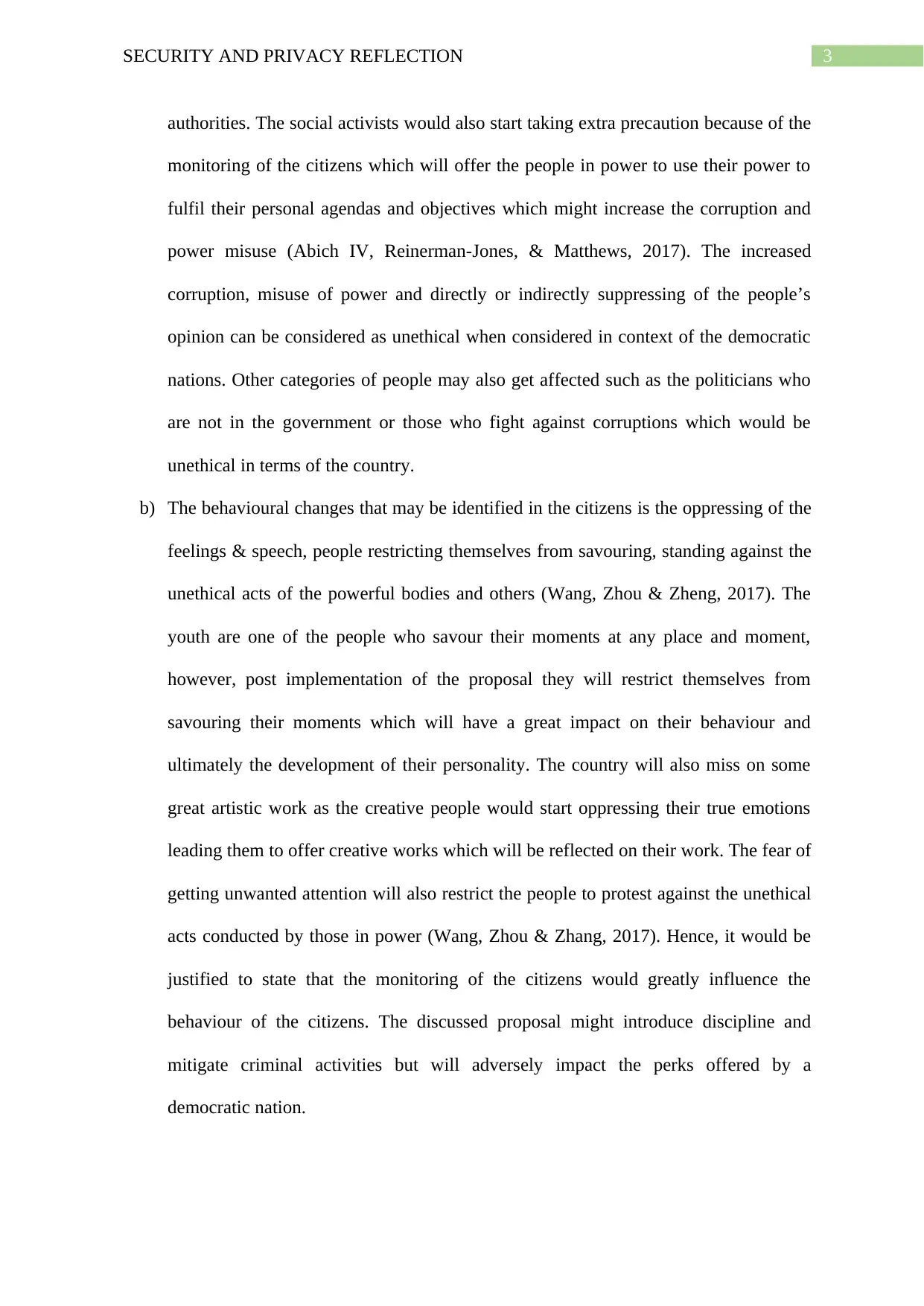
3SECURITY AND PRIVACY REFLECTION
authorities. The social activists would also start taking extra precaution because of the
monitoring of the citizens which will offer the people in power to use their power to
fulfil their personal agendas and objectives which might increase the corruption and
power misuse (Abich IV, Reinerman-Jones, & Matthews, 2017). The increased
corruption, misuse of power and directly or indirectly suppressing of the people’s
opinion can be considered as unethical when considered in context of the democratic
nations. Other categories of people may also get affected such as the politicians who
are not in the government or those who fight against corruptions which would be
unethical in terms of the country.
b) The behavioural changes that may be identified in the citizens is the oppressing of the
feelings & speech, people restricting themselves from savouring, standing against the
unethical acts of the powerful bodies and others (Wang, Zhou & Zheng, 2017). The
youth are one of the people who savour their moments at any place and moment,
however, post implementation of the proposal they will restrict themselves from
savouring their moments which will have a great impact on their behaviour and
ultimately the development of their personality. The country will also miss on some
great artistic work as the creative people would start oppressing their true emotions
leading them to offer creative works which will be reflected on their work. The fear of
getting unwanted attention will also restrict the people to protest against the unethical
acts conducted by those in power (Wang, Zhou & Zhang, 2017). Hence, it would be
justified to state that the monitoring of the citizens would greatly influence the
behaviour of the citizens. The discussed proposal might introduce discipline and
mitigate criminal activities but will adversely impact the perks offered by a
democratic nation.
authorities. The social activists would also start taking extra precaution because of the
monitoring of the citizens which will offer the people in power to use their power to
fulfil their personal agendas and objectives which might increase the corruption and
power misuse (Abich IV, Reinerman-Jones, & Matthews, 2017). The increased
corruption, misuse of power and directly or indirectly suppressing of the people’s
opinion can be considered as unethical when considered in context of the democratic
nations. Other categories of people may also get affected such as the politicians who
are not in the government or those who fight against corruptions which would be
unethical in terms of the country.
b) The behavioural changes that may be identified in the citizens is the oppressing of the
feelings & speech, people restricting themselves from savouring, standing against the
unethical acts of the powerful bodies and others (Wang, Zhou & Zheng, 2017). The
youth are one of the people who savour their moments at any place and moment,
however, post implementation of the proposal they will restrict themselves from
savouring their moments which will have a great impact on their behaviour and
ultimately the development of their personality. The country will also miss on some
great artistic work as the creative people would start oppressing their true emotions
leading them to offer creative works which will be reflected on their work. The fear of
getting unwanted attention will also restrict the people to protest against the unethical
acts conducted by those in power (Wang, Zhou & Zhang, 2017). Hence, it would be
justified to state that the monitoring of the citizens would greatly influence the
behaviour of the citizens. The discussed proposal might introduce discipline and
mitigate criminal activities but will adversely impact the perks offered by a
democratic nation.
Secure Best Marks with AI Grader
Need help grading? Try our AI Grader for instant feedback on your assignments.
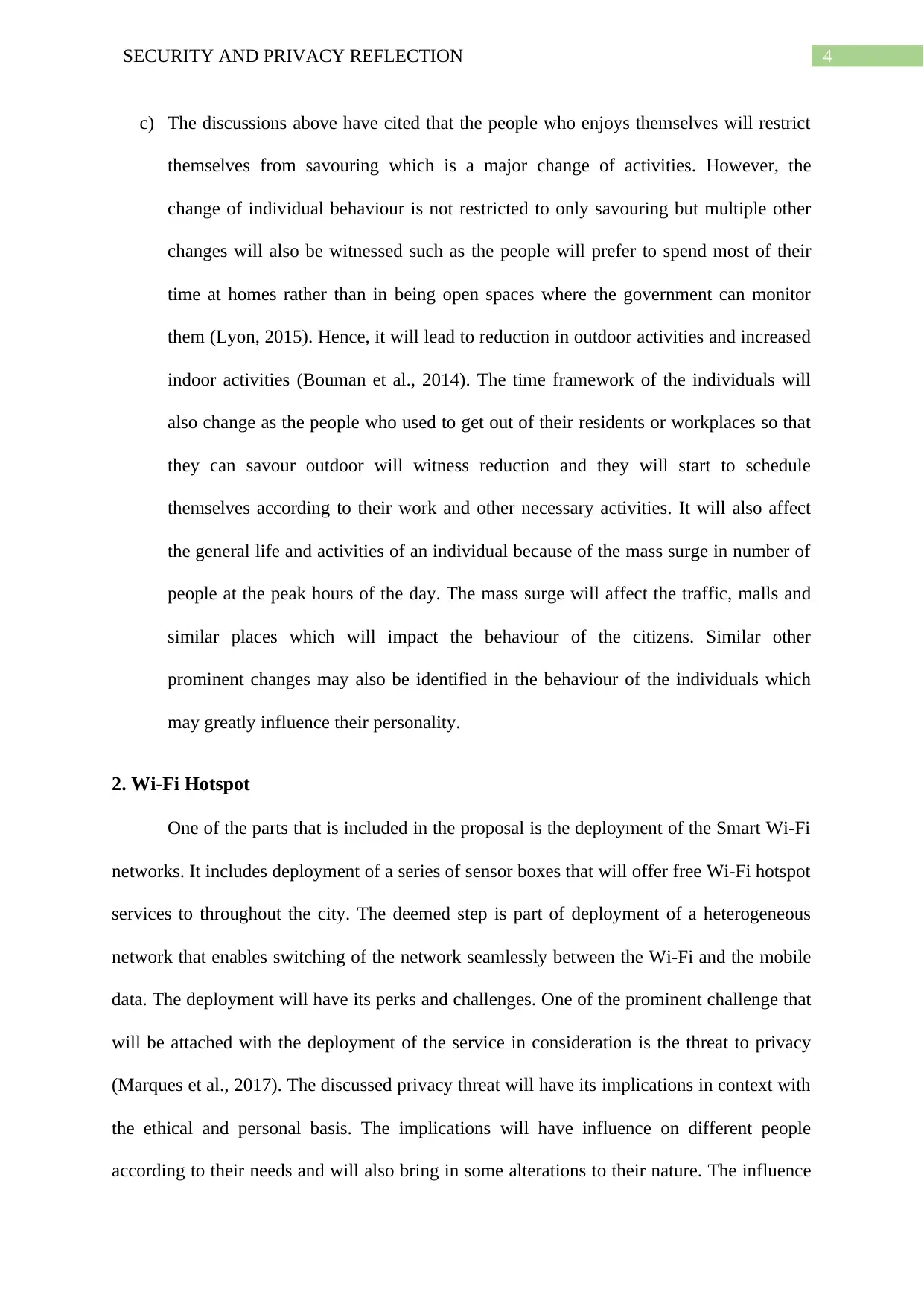
4SECURITY AND PRIVACY REFLECTION
c) The discussions above have cited that the people who enjoys themselves will restrict
themselves from savouring which is a major change of activities. However, the
change of individual behaviour is not restricted to only savouring but multiple other
changes will also be witnessed such as the people will prefer to spend most of their
time at homes rather than in being open spaces where the government can monitor
them (Lyon, 2015). Hence, it will lead to reduction in outdoor activities and increased
indoor activities (Bouman et al., 2014). The time framework of the individuals will
also change as the people who used to get out of their residents or workplaces so that
they can savour outdoor will witness reduction and they will start to schedule
themselves according to their work and other necessary activities. It will also affect
the general life and activities of an individual because of the mass surge in number of
people at the peak hours of the day. The mass surge will affect the traffic, malls and
similar places which will impact the behaviour of the citizens. Similar other
prominent changes may also be identified in the behaviour of the individuals which
may greatly influence their personality.
2. Wi-Fi Hotspot
One of the parts that is included in the proposal is the deployment of the Smart Wi-Fi
networks. It includes deployment of a series of sensor boxes that will offer free Wi-Fi hotspot
services to throughout the city. The deemed step is part of deployment of a heterogeneous
network that enables switching of the network seamlessly between the Wi-Fi and the mobile
data. The deployment will have its perks and challenges. One of the prominent challenge that
will be attached with the deployment of the service in consideration is the threat to privacy
(Marques et al., 2017). The discussed privacy threat will have its implications in context with
the ethical and personal basis. The implications will have influence on different people
according to their needs and will also bring in some alterations to their nature. The influence
c) The discussions above have cited that the people who enjoys themselves will restrict
themselves from savouring which is a major change of activities. However, the
change of individual behaviour is not restricted to only savouring but multiple other
changes will also be witnessed such as the people will prefer to spend most of their
time at homes rather than in being open spaces where the government can monitor
them (Lyon, 2015). Hence, it will lead to reduction in outdoor activities and increased
indoor activities (Bouman et al., 2014). The time framework of the individuals will
also change as the people who used to get out of their residents or workplaces so that
they can savour outdoor will witness reduction and they will start to schedule
themselves according to their work and other necessary activities. It will also affect
the general life and activities of an individual because of the mass surge in number of
people at the peak hours of the day. The mass surge will affect the traffic, malls and
similar places which will impact the behaviour of the citizens. Similar other
prominent changes may also be identified in the behaviour of the individuals which
may greatly influence their personality.
2. Wi-Fi Hotspot
One of the parts that is included in the proposal is the deployment of the Smart Wi-Fi
networks. It includes deployment of a series of sensor boxes that will offer free Wi-Fi hotspot
services to throughout the city. The deemed step is part of deployment of a heterogeneous
network that enables switching of the network seamlessly between the Wi-Fi and the mobile
data. The deployment will have its perks and challenges. One of the prominent challenge that
will be attached with the deployment of the service in consideration is the threat to privacy
(Marques et al., 2017). The discussed privacy threat will have its implications in context with
the ethical and personal basis. The implications will have influence on different people
according to their needs and will also bring in some alterations to their nature. The influence
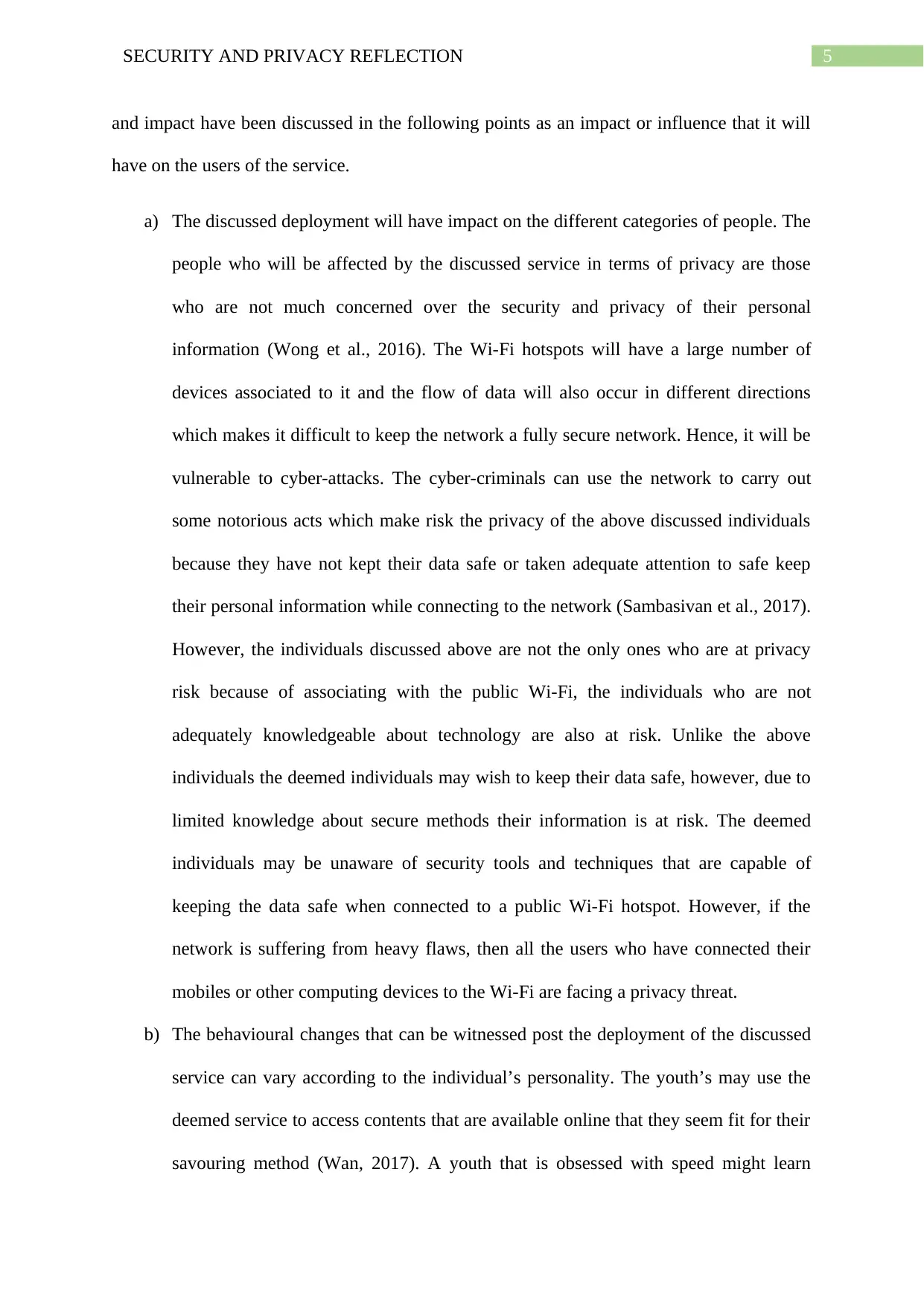
5SECURITY AND PRIVACY REFLECTION
and impact have been discussed in the following points as an impact or influence that it will
have on the users of the service.
a) The discussed deployment will have impact on the different categories of people. The
people who will be affected by the discussed service in terms of privacy are those
who are not much concerned over the security and privacy of their personal
information (Wong et al., 2016). The Wi-Fi hotspots will have a large number of
devices associated to it and the flow of data will also occur in different directions
which makes it difficult to keep the network a fully secure network. Hence, it will be
vulnerable to cyber-attacks. The cyber-criminals can use the network to carry out
some notorious acts which make risk the privacy of the above discussed individuals
because they have not kept their data safe or taken adequate attention to safe keep
their personal information while connecting to the network (Sambasivan et al., 2017).
However, the individuals discussed above are not the only ones who are at privacy
risk because of associating with the public Wi-Fi, the individuals who are not
adequately knowledgeable about technology are also at risk. Unlike the above
individuals the deemed individuals may wish to keep their data safe, however, due to
limited knowledge about secure methods their information is at risk. The deemed
individuals may be unaware of security tools and techniques that are capable of
keeping the data safe when connected to a public Wi-Fi hotspot. However, if the
network is suffering from heavy flaws, then all the users who have connected their
mobiles or other computing devices to the Wi-Fi are facing a privacy threat.
b) The behavioural changes that can be witnessed post the deployment of the discussed
service can vary according to the individual’s personality. The youth’s may use the
deemed service to access contents that are available online that they seem fit for their
savouring method (Wan, 2017). A youth that is obsessed with speed might learn
and impact have been discussed in the following points as an impact or influence that it will
have on the users of the service.
a) The discussed deployment will have impact on the different categories of people. The
people who will be affected by the discussed service in terms of privacy are those
who are not much concerned over the security and privacy of their personal
information (Wong et al., 2016). The Wi-Fi hotspots will have a large number of
devices associated to it and the flow of data will also occur in different directions
which makes it difficult to keep the network a fully secure network. Hence, it will be
vulnerable to cyber-attacks. The cyber-criminals can use the network to carry out
some notorious acts which make risk the privacy of the above discussed individuals
because they have not kept their data safe or taken adequate attention to safe keep
their personal information while connecting to the network (Sambasivan et al., 2017).
However, the individuals discussed above are not the only ones who are at privacy
risk because of associating with the public Wi-Fi, the individuals who are not
adequately knowledgeable about technology are also at risk. Unlike the above
individuals the deemed individuals may wish to keep their data safe, however, due to
limited knowledge about secure methods their information is at risk. The deemed
individuals may be unaware of security tools and techniques that are capable of
keeping the data safe when connected to a public Wi-Fi hotspot. However, if the
network is suffering from heavy flaws, then all the users who have connected their
mobiles or other computing devices to the Wi-Fi are facing a privacy threat.
b) The behavioural changes that can be witnessed post the deployment of the discussed
service can vary according to the individual’s personality. The youth’s may use the
deemed service to access contents that are available online that they seem fit for their
savouring method (Wan, 2017). A youth that is obsessed with speed might learn
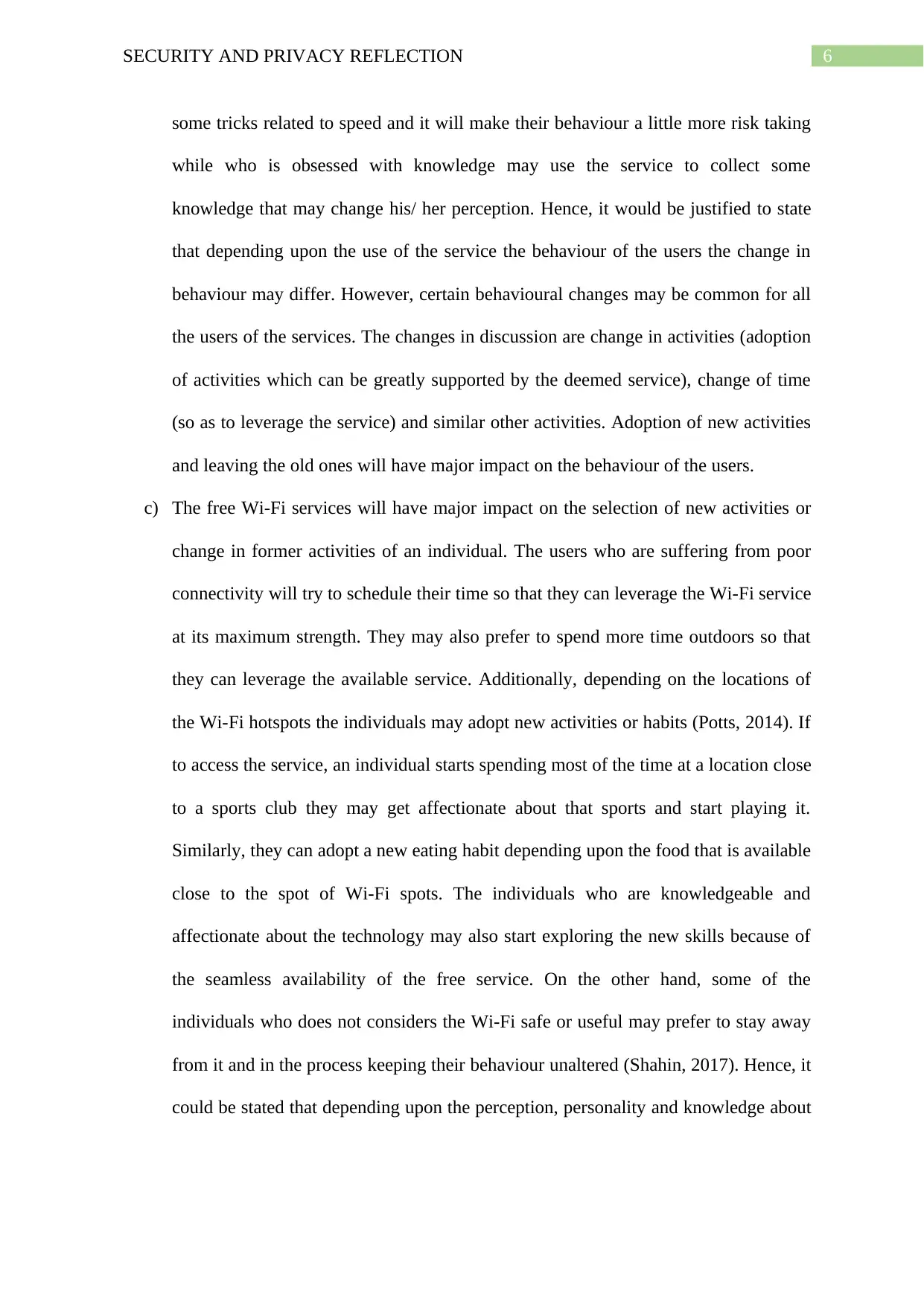
6SECURITY AND PRIVACY REFLECTION
some tricks related to speed and it will make their behaviour a little more risk taking
while who is obsessed with knowledge may use the service to collect some
knowledge that may change his/ her perception. Hence, it would be justified to state
that depending upon the use of the service the behaviour of the users the change in
behaviour may differ. However, certain behavioural changes may be common for all
the users of the services. The changes in discussion are change in activities (adoption
of activities which can be greatly supported by the deemed service), change of time
(so as to leverage the service) and similar other activities. Adoption of new activities
and leaving the old ones will have major impact on the behaviour of the users.
c) The free Wi-Fi services will have major impact on the selection of new activities or
change in former activities of an individual. The users who are suffering from poor
connectivity will try to schedule their time so that they can leverage the Wi-Fi service
at its maximum strength. They may also prefer to spend more time outdoors so that
they can leverage the available service. Additionally, depending on the locations of
the Wi-Fi hotspots the individuals may adopt new activities or habits (Potts, 2014). If
to access the service, an individual starts spending most of the time at a location close
to a sports club they may get affectionate about that sports and start playing it.
Similarly, they can adopt a new eating habit depending upon the food that is available
close to the spot of Wi-Fi spots. The individuals who are knowledgeable and
affectionate about the technology may also start exploring the new skills because of
the seamless availability of the free service. On the other hand, some of the
individuals who does not considers the Wi-Fi safe or useful may prefer to stay away
from it and in the process keeping their behaviour unaltered (Shahin, 2017). Hence, it
could be stated that depending upon the perception, personality and knowledge about
some tricks related to speed and it will make their behaviour a little more risk taking
while who is obsessed with knowledge may use the service to collect some
knowledge that may change his/ her perception. Hence, it would be justified to state
that depending upon the use of the service the behaviour of the users the change in
behaviour may differ. However, certain behavioural changes may be common for all
the users of the services. The changes in discussion are change in activities (adoption
of activities which can be greatly supported by the deemed service), change of time
(so as to leverage the service) and similar other activities. Adoption of new activities
and leaving the old ones will have major impact on the behaviour of the users.
c) The free Wi-Fi services will have major impact on the selection of new activities or
change in former activities of an individual. The users who are suffering from poor
connectivity will try to schedule their time so that they can leverage the Wi-Fi service
at its maximum strength. They may also prefer to spend more time outdoors so that
they can leverage the available service. Additionally, depending on the locations of
the Wi-Fi hotspots the individuals may adopt new activities or habits (Potts, 2014). If
to access the service, an individual starts spending most of the time at a location close
to a sports club they may get affectionate about that sports and start playing it.
Similarly, they can adopt a new eating habit depending upon the food that is available
close to the spot of Wi-Fi spots. The individuals who are knowledgeable and
affectionate about the technology may also start exploring the new skills because of
the seamless availability of the free service. On the other hand, some of the
individuals who does not considers the Wi-Fi safe or useful may prefer to stay away
from it and in the process keeping their behaviour unaltered (Shahin, 2017). Hence, it
could be stated that depending upon the perception, personality and knowledge about
Paraphrase This Document
Need a fresh take? Get an instant paraphrase of this document with our AI Paraphraser
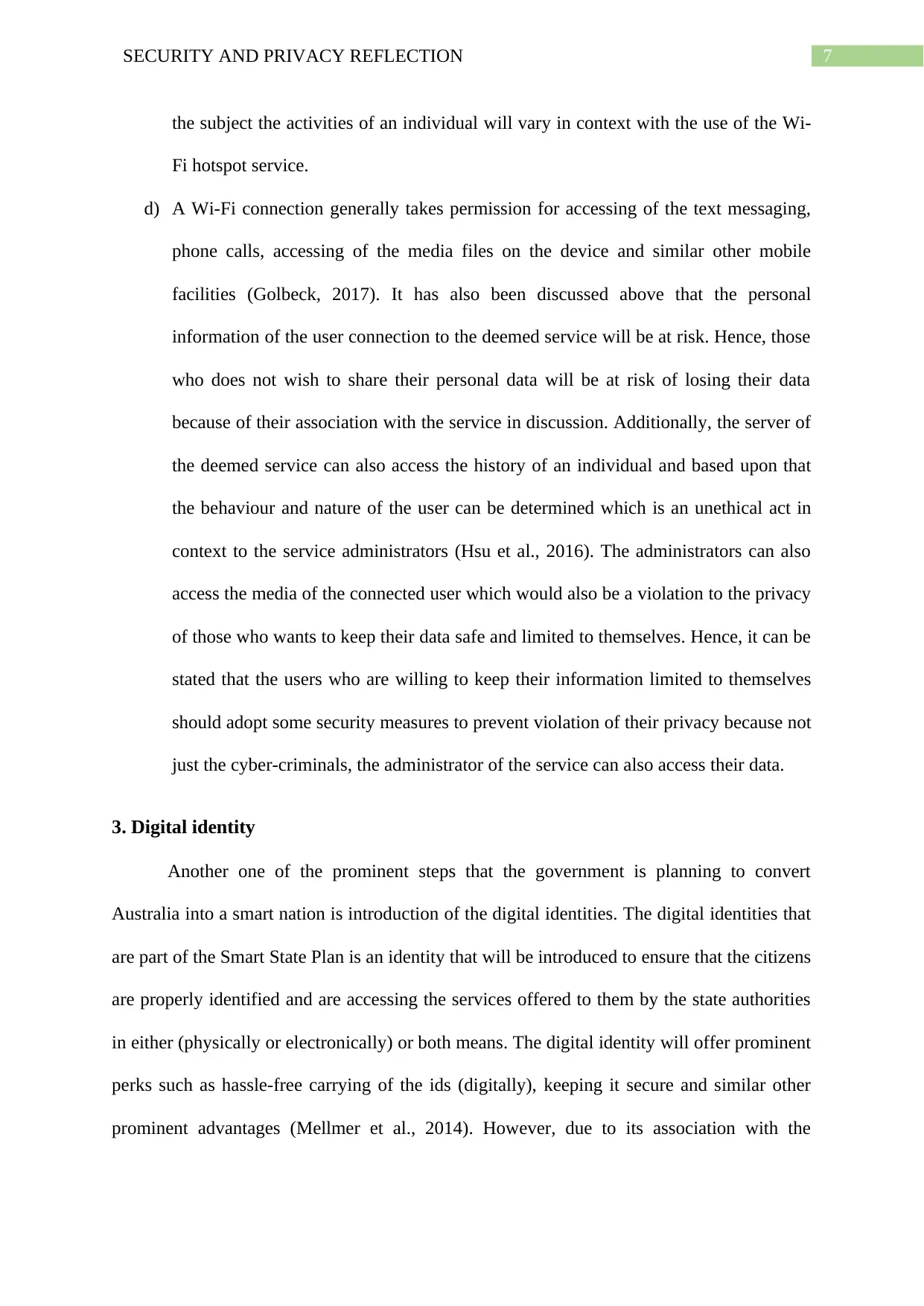
7SECURITY AND PRIVACY REFLECTION
the subject the activities of an individual will vary in context with the use of the Wi-
Fi hotspot service.
d) A Wi-Fi connection generally takes permission for accessing of the text messaging,
phone calls, accessing of the media files on the device and similar other mobile
facilities (Golbeck, 2017). It has also been discussed above that the personal
information of the user connection to the deemed service will be at risk. Hence, those
who does not wish to share their personal data will be at risk of losing their data
because of their association with the service in discussion. Additionally, the server of
the deemed service can also access the history of an individual and based upon that
the behaviour and nature of the user can be determined which is an unethical act in
context to the service administrators (Hsu et al., 2016). The administrators can also
access the media of the connected user which would also be a violation to the privacy
of those who wants to keep their data safe and limited to themselves. Hence, it can be
stated that the users who are willing to keep their information limited to themselves
should adopt some security measures to prevent violation of their privacy because not
just the cyber-criminals, the administrator of the service can also access their data.
3. Digital identity
Another one of the prominent steps that the government is planning to convert
Australia into a smart nation is introduction of the digital identities. The digital identities that
are part of the Smart State Plan is an identity that will be introduced to ensure that the citizens
are properly identified and are accessing the services offered to them by the state authorities
in either (physically or electronically) or both means. The digital identity will offer prominent
perks such as hassle-free carrying of the ids (digitally), keeping it secure and similar other
prominent advantages (Mellmer et al., 2014). However, due to its association with the
the subject the activities of an individual will vary in context with the use of the Wi-
Fi hotspot service.
d) A Wi-Fi connection generally takes permission for accessing of the text messaging,
phone calls, accessing of the media files on the device and similar other mobile
facilities (Golbeck, 2017). It has also been discussed above that the personal
information of the user connection to the deemed service will be at risk. Hence, those
who does not wish to share their personal data will be at risk of losing their data
because of their association with the service in discussion. Additionally, the server of
the deemed service can also access the history of an individual and based upon that
the behaviour and nature of the user can be determined which is an unethical act in
context to the service administrators (Hsu et al., 2016). The administrators can also
access the media of the connected user which would also be a violation to the privacy
of those who wants to keep their data safe and limited to themselves. Hence, it can be
stated that the users who are willing to keep their information limited to themselves
should adopt some security measures to prevent violation of their privacy because not
just the cyber-criminals, the administrator of the service can also access their data.
3. Digital identity
Another one of the prominent steps that the government is planning to convert
Australia into a smart nation is introduction of the digital identities. The digital identities that
are part of the Smart State Plan is an identity that will be introduced to ensure that the citizens
are properly identified and are accessing the services offered to them by the state authorities
in either (physically or electronically) or both means. The digital identity will offer prominent
perks such as hassle-free carrying of the ids (digitally), keeping it secure and similar other
prominent advantages (Mellmer et al., 2014). However, due to its association with the
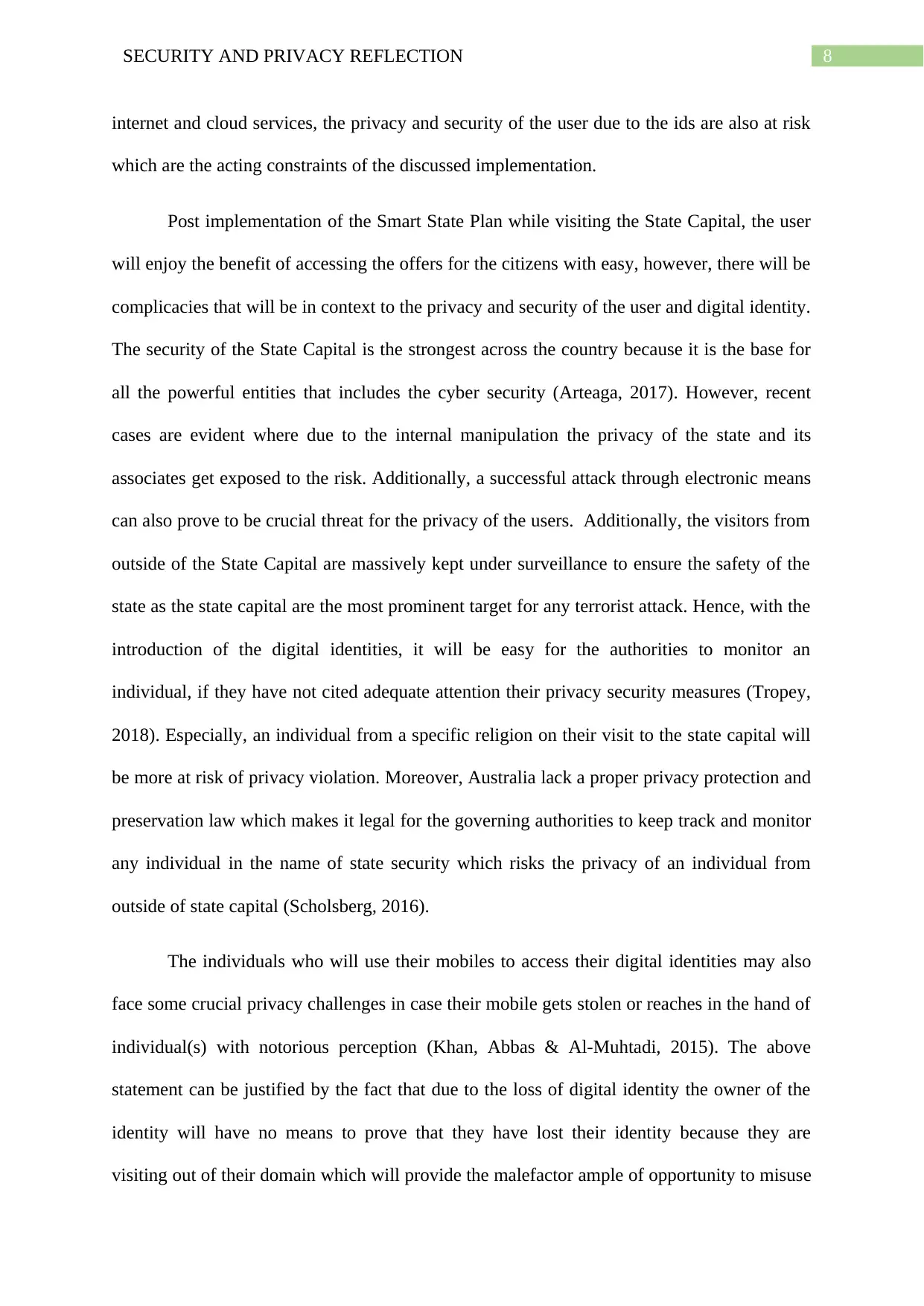
8SECURITY AND PRIVACY REFLECTION
internet and cloud services, the privacy and security of the user due to the ids are also at risk
which are the acting constraints of the discussed implementation.
Post implementation of the Smart State Plan while visiting the State Capital, the user
will enjoy the benefit of accessing the offers for the citizens with easy, however, there will be
complicacies that will be in context to the privacy and security of the user and digital identity.
The security of the State Capital is the strongest across the country because it is the base for
all the powerful entities that includes the cyber security (Arteaga, 2017). However, recent
cases are evident where due to the internal manipulation the privacy of the state and its
associates get exposed to the risk. Additionally, a successful attack through electronic means
can also prove to be crucial threat for the privacy of the users. Additionally, the visitors from
outside of the State Capital are massively kept under surveillance to ensure the safety of the
state as the state capital are the most prominent target for any terrorist attack. Hence, with the
introduction of the digital identities, it will be easy for the authorities to monitor an
individual, if they have not cited adequate attention their privacy security measures (Tropey,
2018). Especially, an individual from a specific religion on their visit to the state capital will
be more at risk of privacy violation. Moreover, Australia lack a proper privacy protection and
preservation law which makes it legal for the governing authorities to keep track and monitor
any individual in the name of state security which risks the privacy of an individual from
outside of state capital (Scholsberg, 2016).
The individuals who will use their mobiles to access their digital identities may also
face some crucial privacy challenges in case their mobile gets stolen or reaches in the hand of
individual(s) with notorious perception (Khan, Abbas & Al-Muhtadi, 2015). The above
statement can be justified by the fact that due to the loss of digital identity the owner of the
identity will have no means to prove that they have lost their identity because they are
visiting out of their domain which will provide the malefactor ample of opportunity to misuse
internet and cloud services, the privacy and security of the user due to the ids are also at risk
which are the acting constraints of the discussed implementation.
Post implementation of the Smart State Plan while visiting the State Capital, the user
will enjoy the benefit of accessing the offers for the citizens with easy, however, there will be
complicacies that will be in context to the privacy and security of the user and digital identity.
The security of the State Capital is the strongest across the country because it is the base for
all the powerful entities that includes the cyber security (Arteaga, 2017). However, recent
cases are evident where due to the internal manipulation the privacy of the state and its
associates get exposed to the risk. Additionally, a successful attack through electronic means
can also prove to be crucial threat for the privacy of the users. Additionally, the visitors from
outside of the State Capital are massively kept under surveillance to ensure the safety of the
state as the state capital are the most prominent target for any terrorist attack. Hence, with the
introduction of the digital identities, it will be easy for the authorities to monitor an
individual, if they have not cited adequate attention their privacy security measures (Tropey,
2018). Especially, an individual from a specific religion on their visit to the state capital will
be more at risk of privacy violation. Moreover, Australia lack a proper privacy protection and
preservation law which makes it legal for the governing authorities to keep track and monitor
any individual in the name of state security which risks the privacy of an individual from
outside of state capital (Scholsberg, 2016).
The individuals who will use their mobiles to access their digital identities may also
face some crucial privacy challenges in case their mobile gets stolen or reaches in the hand of
individual(s) with notorious perception (Khan, Abbas & Al-Muhtadi, 2015). The above
statement can be justified by the fact that due to the loss of digital identity the owner of the
identity will have no means to prove that they have lost their identity because they are
visiting out of their domain which will provide the malefactor ample of opportunity to misuse
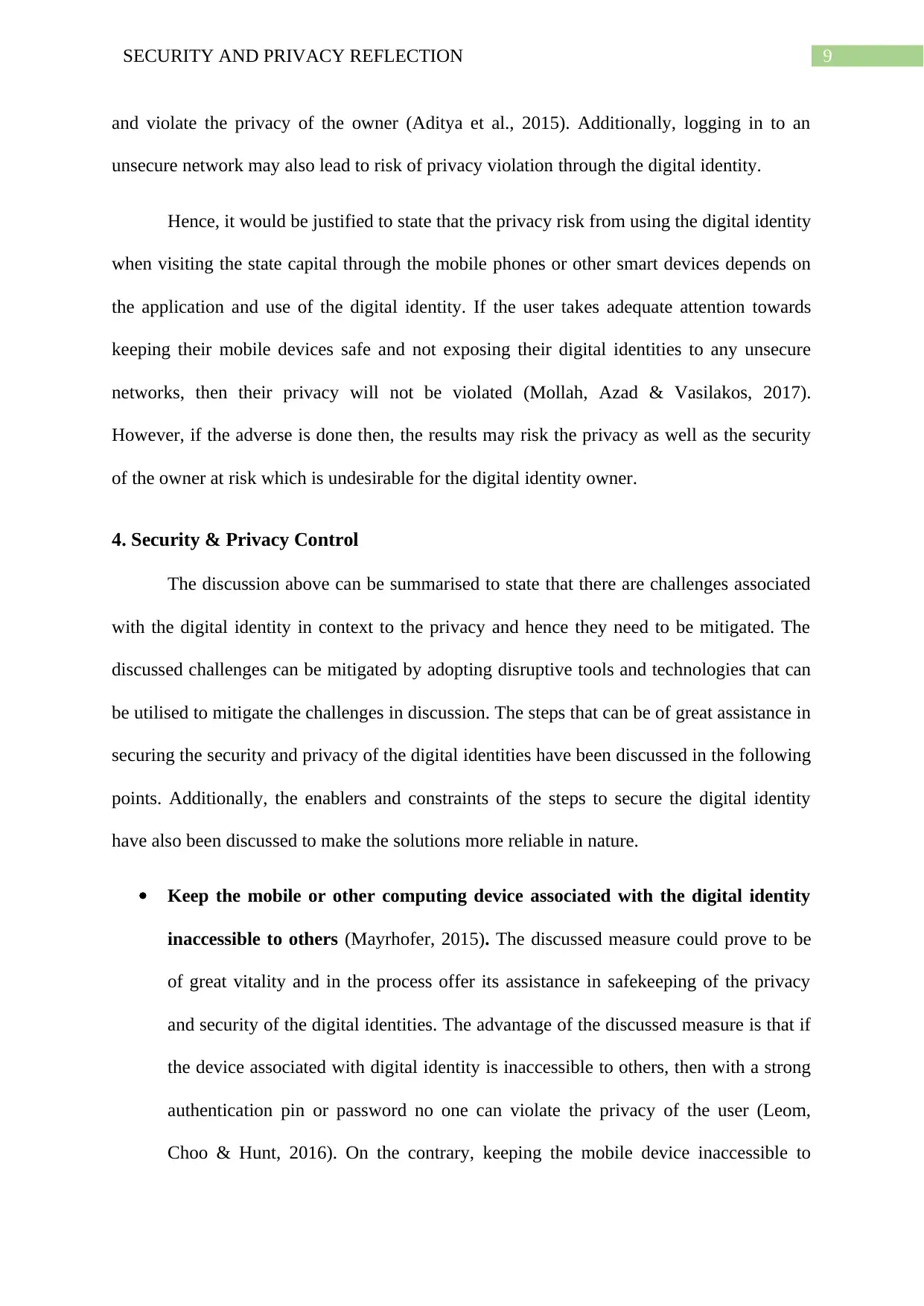
9SECURITY AND PRIVACY REFLECTION
and violate the privacy of the owner (Aditya et al., 2015). Additionally, logging in to an
unsecure network may also lead to risk of privacy violation through the digital identity.
Hence, it would be justified to state that the privacy risk from using the digital identity
when visiting the state capital through the mobile phones or other smart devices depends on
the application and use of the digital identity. If the user takes adequate attention towards
keeping their mobile devices safe and not exposing their digital identities to any unsecure
networks, then their privacy will not be violated (Mollah, Azad & Vasilakos, 2017).
However, if the adverse is done then, the results may risk the privacy as well as the security
of the owner at risk which is undesirable for the digital identity owner.
4. Security & Privacy Control
The discussion above can be summarised to state that there are challenges associated
with the digital identity in context to the privacy and hence they need to be mitigated. The
discussed challenges can be mitigated by adopting disruptive tools and technologies that can
be utilised to mitigate the challenges in discussion. The steps that can be of great assistance in
securing the security and privacy of the digital identities have been discussed in the following
points. Additionally, the enablers and constraints of the steps to secure the digital identity
have also been discussed to make the solutions more reliable in nature.
Keep the mobile or other computing device associated with the digital identity
inaccessible to others (Mayrhofer, 2015). The discussed measure could prove to be
of great vitality and in the process offer its assistance in safekeeping of the privacy
and security of the digital identities. The advantage of the discussed measure is that if
the device associated with digital identity is inaccessible to others, then with a strong
authentication pin or password no one can violate the privacy of the user (Leom,
Choo & Hunt, 2016). On the contrary, keeping the mobile device inaccessible to
and violate the privacy of the owner (Aditya et al., 2015). Additionally, logging in to an
unsecure network may also lead to risk of privacy violation through the digital identity.
Hence, it would be justified to state that the privacy risk from using the digital identity
when visiting the state capital through the mobile phones or other smart devices depends on
the application and use of the digital identity. If the user takes adequate attention towards
keeping their mobile devices safe and not exposing their digital identities to any unsecure
networks, then their privacy will not be violated (Mollah, Azad & Vasilakos, 2017).
However, if the adverse is done then, the results may risk the privacy as well as the security
of the owner at risk which is undesirable for the digital identity owner.
4. Security & Privacy Control
The discussion above can be summarised to state that there are challenges associated
with the digital identity in context to the privacy and hence they need to be mitigated. The
discussed challenges can be mitigated by adopting disruptive tools and technologies that can
be utilised to mitigate the challenges in discussion. The steps that can be of great assistance in
securing the security and privacy of the digital identities have been discussed in the following
points. Additionally, the enablers and constraints of the steps to secure the digital identity
have also been discussed to make the solutions more reliable in nature.
Keep the mobile or other computing device associated with the digital identity
inaccessible to others (Mayrhofer, 2015). The discussed measure could prove to be
of great vitality and in the process offer its assistance in safekeeping of the privacy
and security of the digital identities. The advantage of the discussed measure is that if
the device associated with digital identity is inaccessible to others, then with a strong
authentication pin or password no one can violate the privacy of the user (Leom,
Choo & Hunt, 2016). On the contrary, keeping the mobile device inaccessible to
Secure Best Marks with AI Grader
Need help grading? Try our AI Grader for instant feedback on your assignments.
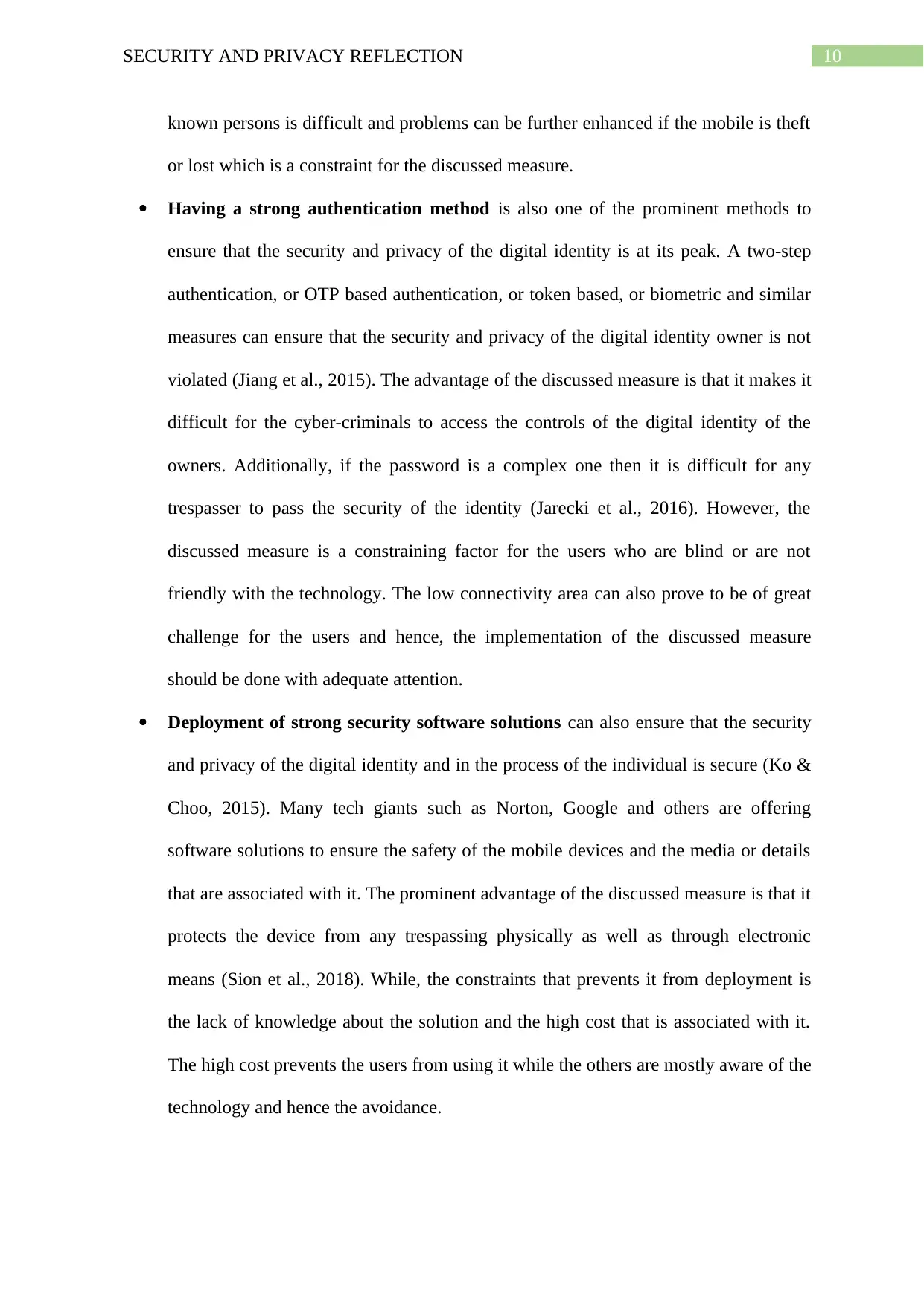
10SECURITY AND PRIVACY REFLECTION
known persons is difficult and problems can be further enhanced if the mobile is theft
or lost which is a constraint for the discussed measure.
Having a strong authentication method is also one of the prominent methods to
ensure that the security and privacy of the digital identity is at its peak. A two-step
authentication, or OTP based authentication, or token based, or biometric and similar
measures can ensure that the security and privacy of the digital identity owner is not
violated (Jiang et al., 2015). The advantage of the discussed measure is that it makes it
difficult for the cyber-criminals to access the controls of the digital identity of the
owners. Additionally, if the password is a complex one then it is difficult for any
trespasser to pass the security of the identity (Jarecki et al., 2016). However, the
discussed measure is a constraining factor for the users who are blind or are not
friendly with the technology. The low connectivity area can also prove to be of great
challenge for the users and hence, the implementation of the discussed measure
should be done with adequate attention.
Deployment of strong security software solutions can also ensure that the security
and privacy of the digital identity and in the process of the individual is secure (Ko &
Choo, 2015). Many tech giants such as Norton, Google and others are offering
software solutions to ensure the safety of the mobile devices and the media or details
that are associated with it. The prominent advantage of the discussed measure is that it
protects the device from any trespassing physically as well as through electronic
means (Sion et al., 2018). While, the constraints that prevents it from deployment is
the lack of knowledge about the solution and the high cost that is associated with it.
The high cost prevents the users from using it while the others are mostly aware of the
technology and hence the avoidance.
known persons is difficult and problems can be further enhanced if the mobile is theft
or lost which is a constraint for the discussed measure.
Having a strong authentication method is also one of the prominent methods to
ensure that the security and privacy of the digital identity is at its peak. A two-step
authentication, or OTP based authentication, or token based, or biometric and similar
measures can ensure that the security and privacy of the digital identity owner is not
violated (Jiang et al., 2015). The advantage of the discussed measure is that it makes it
difficult for the cyber-criminals to access the controls of the digital identity of the
owners. Additionally, if the password is a complex one then it is difficult for any
trespasser to pass the security of the identity (Jarecki et al., 2016). However, the
discussed measure is a constraining factor for the users who are blind or are not
friendly with the technology. The low connectivity area can also prove to be of great
challenge for the users and hence, the implementation of the discussed measure
should be done with adequate attention.
Deployment of strong security software solutions can also ensure that the security
and privacy of the digital identity and in the process of the individual is secure (Ko &
Choo, 2015). Many tech giants such as Norton, Google and others are offering
software solutions to ensure the safety of the mobile devices and the media or details
that are associated with it. The prominent advantage of the discussed measure is that it
protects the device from any trespassing physically as well as through electronic
means (Sion et al., 2018). While, the constraints that prevents it from deployment is
the lack of knowledge about the solution and the high cost that is associated with it.
The high cost prevents the users from using it while the others are mostly aware of the
technology and hence the avoidance.

11SECURITY AND PRIVACY REFLECTION
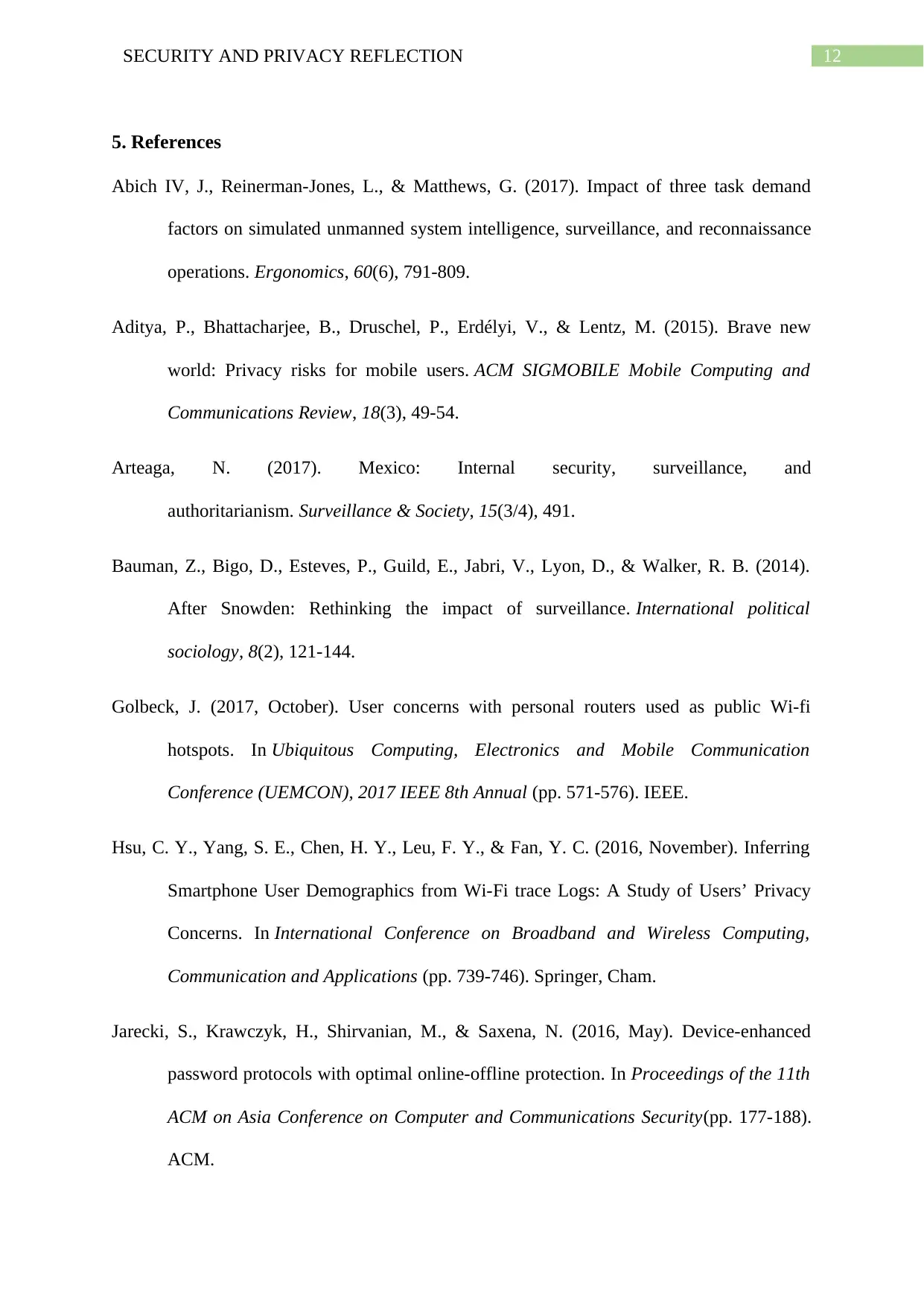
12SECURITY AND PRIVACY REFLECTION
5. References
Abich IV, J., Reinerman-Jones, L., & Matthews, G. (2017). Impact of three task demand
factors on simulated unmanned system intelligence, surveillance, and reconnaissance
operations. Ergonomics, 60(6), 791-809.
Aditya, P., Bhattacharjee, B., Druschel, P., Erdélyi, V., & Lentz, M. (2015). Brave new
world: Privacy risks for mobile users. ACM SIGMOBILE Mobile Computing and
Communications Review, 18(3), 49-54.
Arteaga, N. (2017). Mexico: Internal security, surveillance, and
authoritarianism. Surveillance & Society, 15(3/4), 491.
Bauman, Z., Bigo, D., Esteves, P., Guild, E., Jabri, V., Lyon, D., & Walker, R. B. (2014).
After Snowden: Rethinking the impact of surveillance. International political
sociology, 8(2), 121-144.
Golbeck, J. (2017, October). User concerns with personal routers used as public Wi-fi
hotspots. In Ubiquitous Computing, Electronics and Mobile Communication
Conference (UEMCON), 2017 IEEE 8th Annual (pp. 571-576). IEEE.
Hsu, C. Y., Yang, S. E., Chen, H. Y., Leu, F. Y., & Fan, Y. C. (2016, November). Inferring
Smartphone User Demographics from Wi-Fi trace Logs: A Study of Users’ Privacy
Concerns. In International Conference on Broadband and Wireless Computing,
Communication and Applications (pp. 739-746). Springer, Cham.
Jarecki, S., Krawczyk, H., Shirvanian, M., & Saxena, N. (2016, May). Device-enhanced
password protocols with optimal online-offline protection. In Proceedings of the 11th
ACM on Asia Conference on Computer and Communications Security(pp. 177-188).
ACM.
5. References
Abich IV, J., Reinerman-Jones, L., & Matthews, G. (2017). Impact of three task demand
factors on simulated unmanned system intelligence, surveillance, and reconnaissance
operations. Ergonomics, 60(6), 791-809.
Aditya, P., Bhattacharjee, B., Druschel, P., Erdélyi, V., & Lentz, M. (2015). Brave new
world: Privacy risks for mobile users. ACM SIGMOBILE Mobile Computing and
Communications Review, 18(3), 49-54.
Arteaga, N. (2017). Mexico: Internal security, surveillance, and
authoritarianism. Surveillance & Society, 15(3/4), 491.
Bauman, Z., Bigo, D., Esteves, P., Guild, E., Jabri, V., Lyon, D., & Walker, R. B. (2014).
After Snowden: Rethinking the impact of surveillance. International political
sociology, 8(2), 121-144.
Golbeck, J. (2017, October). User concerns with personal routers used as public Wi-fi
hotspots. In Ubiquitous Computing, Electronics and Mobile Communication
Conference (UEMCON), 2017 IEEE 8th Annual (pp. 571-576). IEEE.
Hsu, C. Y., Yang, S. E., Chen, H. Y., Leu, F. Y., & Fan, Y. C. (2016, November). Inferring
Smartphone User Demographics from Wi-Fi trace Logs: A Study of Users’ Privacy
Concerns. In International Conference on Broadband and Wireless Computing,
Communication and Applications (pp. 739-746). Springer, Cham.
Jarecki, S., Krawczyk, H., Shirvanian, M., & Saxena, N. (2016, May). Device-enhanced
password protocols with optimal online-offline protection. In Proceedings of the 11th
ACM on Asia Conference on Computer and Communications Security(pp. 177-188).
ACM.
Paraphrase This Document
Need a fresh take? Get an instant paraphrase of this document with our AI Paraphraser
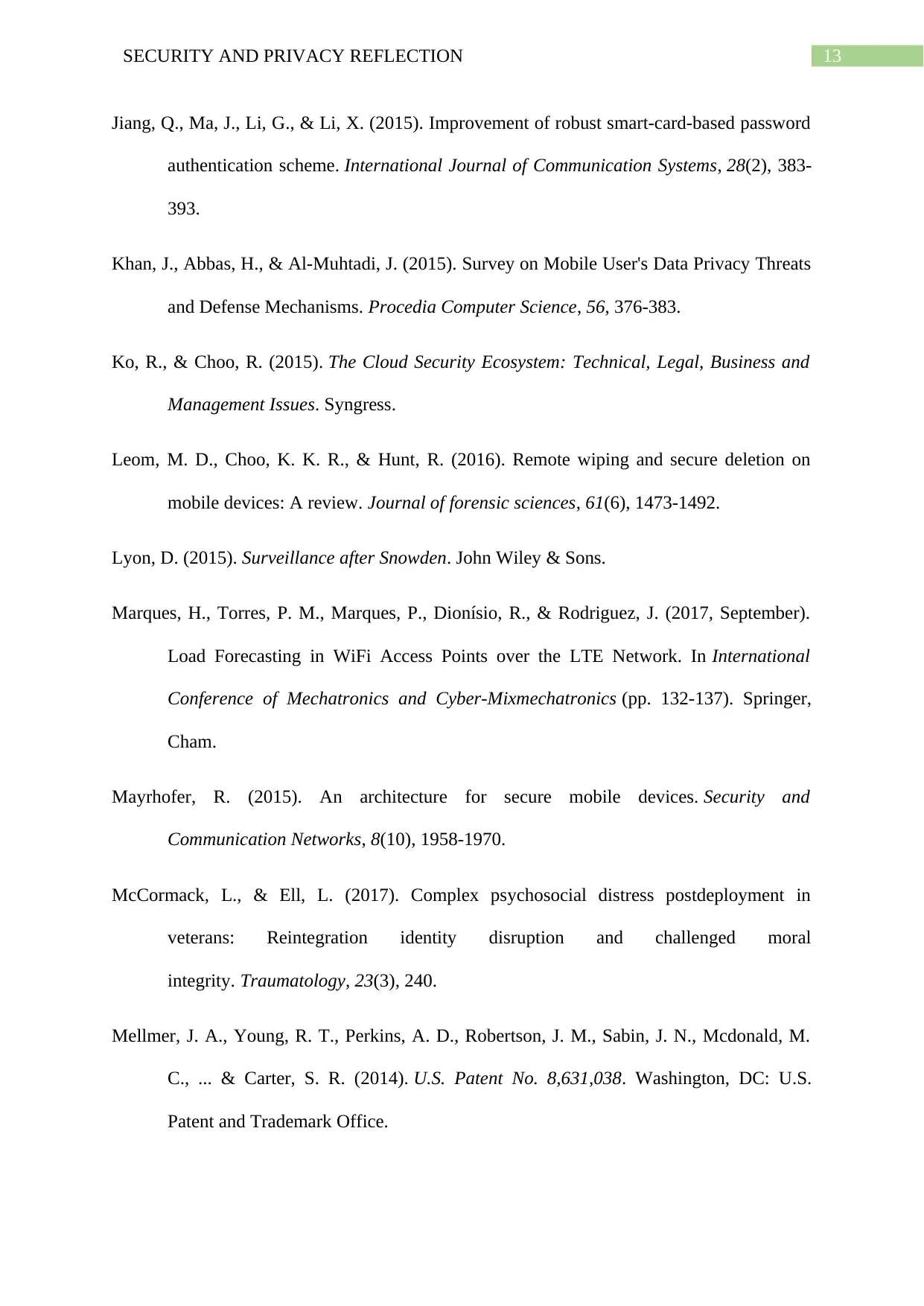
13SECURITY AND PRIVACY REFLECTION
Jiang, Q., Ma, J., Li, G., & Li, X. (2015). Improvement of robust smart‐card‐based password
authentication scheme. International Journal of Communication Systems, 28(2), 383-
393.
Khan, J., Abbas, H., & Al-Muhtadi, J. (2015). Survey on Mobile User's Data Privacy Threats
and Defense Mechanisms. Procedia Computer Science, 56, 376-383.
Ko, R., & Choo, R. (2015). The Cloud Security Ecosystem: Technical, Legal, Business and
Management Issues. Syngress.
Leom, M. D., Choo, K. K. R., & Hunt, R. (2016). Remote wiping and secure deletion on
mobile devices: A review. Journal of forensic sciences, 61(6), 1473-1492.
Lyon, D. (2015). Surveillance after Snowden. John Wiley & Sons.
Marques, H., Torres, P. M., Marques, P., Dionísio, R., & Rodriguez, J. (2017, September).
Load Forecasting in WiFi Access Points over the LTE Network. In International
Conference of Mechatronics and Cyber-Mixmechatronics (pp. 132-137). Springer,
Cham.
Mayrhofer, R. (2015). An architecture for secure mobile devices. Security and
Communication Networks, 8(10), 1958-1970.
McCormack, L., & Ell, L. (2017). Complex psychosocial distress postdeployment in
veterans: Reintegration identity disruption and challenged moral
integrity. Traumatology, 23(3), 240.
Mellmer, J. A., Young, R. T., Perkins, A. D., Robertson, J. M., Sabin, J. N., Mcdonald, M.
C., ... & Carter, S. R. (2014). U.S. Patent No. 8,631,038. Washington, DC: U.S.
Patent and Trademark Office.
Jiang, Q., Ma, J., Li, G., & Li, X. (2015). Improvement of robust smart‐card‐based password
authentication scheme. International Journal of Communication Systems, 28(2), 383-
393.
Khan, J., Abbas, H., & Al-Muhtadi, J. (2015). Survey on Mobile User's Data Privacy Threats
and Defense Mechanisms. Procedia Computer Science, 56, 376-383.
Ko, R., & Choo, R. (2015). The Cloud Security Ecosystem: Technical, Legal, Business and
Management Issues. Syngress.
Leom, M. D., Choo, K. K. R., & Hunt, R. (2016). Remote wiping and secure deletion on
mobile devices: A review. Journal of forensic sciences, 61(6), 1473-1492.
Lyon, D. (2015). Surveillance after Snowden. John Wiley & Sons.
Marques, H., Torres, P. M., Marques, P., Dionísio, R., & Rodriguez, J. (2017, September).
Load Forecasting in WiFi Access Points over the LTE Network. In International
Conference of Mechatronics and Cyber-Mixmechatronics (pp. 132-137). Springer,
Cham.
Mayrhofer, R. (2015). An architecture for secure mobile devices. Security and
Communication Networks, 8(10), 1958-1970.
McCormack, L., & Ell, L. (2017). Complex psychosocial distress postdeployment in
veterans: Reintegration identity disruption and challenged moral
integrity. Traumatology, 23(3), 240.
Mellmer, J. A., Young, R. T., Perkins, A. D., Robertson, J. M., Sabin, J. N., Mcdonald, M.
C., ... & Carter, S. R. (2014). U.S. Patent No. 8,631,038. Washington, DC: U.S.
Patent and Trademark Office.
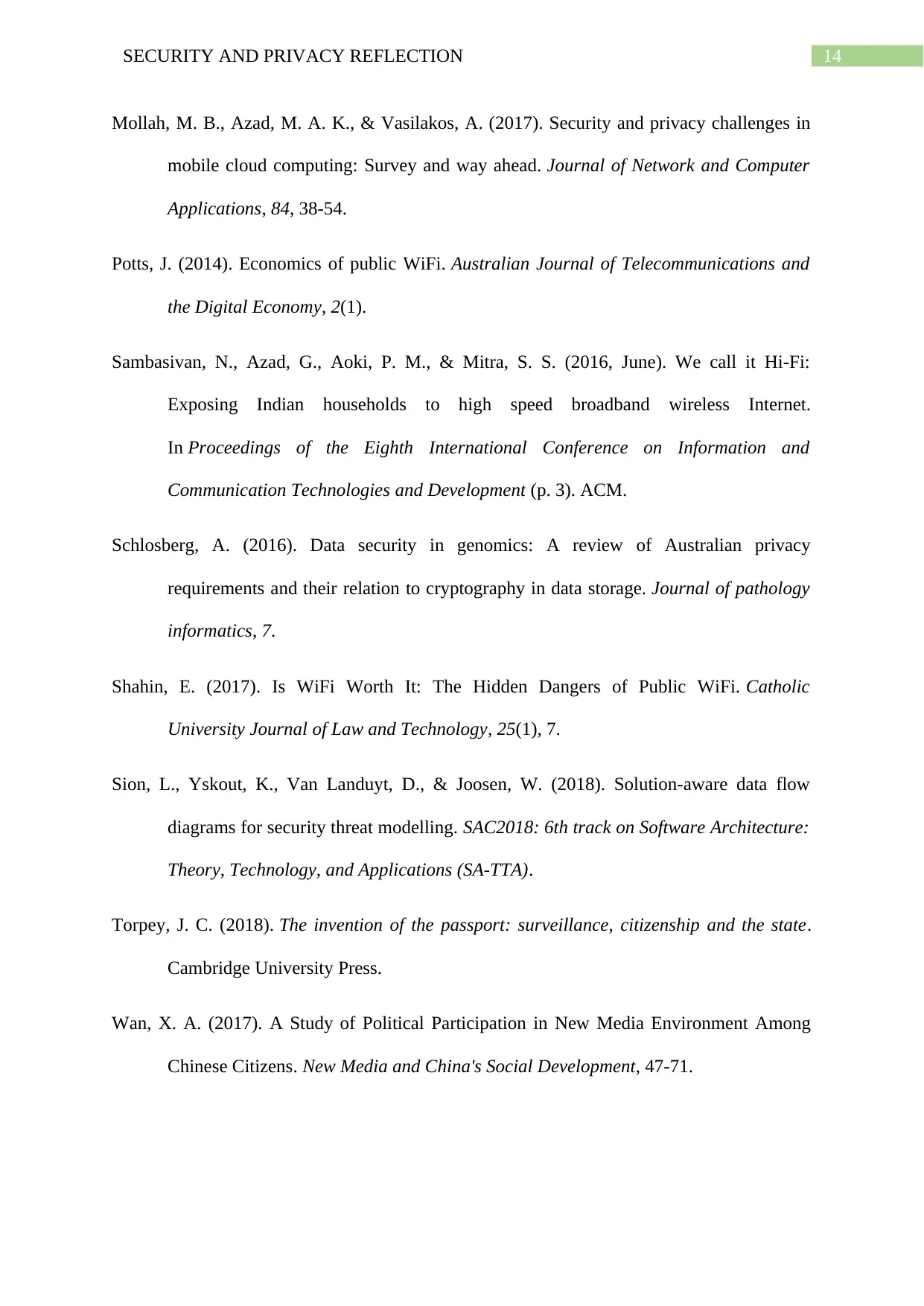
14SECURITY AND PRIVACY REFLECTION
Mollah, M. B., Azad, M. A. K., & Vasilakos, A. (2017). Security and privacy challenges in
mobile cloud computing: Survey and way ahead. Journal of Network and Computer
Applications, 84, 38-54.
Potts, J. (2014). Economics of public WiFi. Australian Journal of Telecommunications and
the Digital Economy, 2(1).
Sambasivan, N., Azad, G., Aoki, P. M., & Mitra, S. S. (2016, June). We call it Hi-Fi:
Exposing Indian households to high speed broadband wireless Internet.
In Proceedings of the Eighth International Conference on Information and
Communication Technologies and Development (p. 3). ACM.
Schlosberg, A. (2016). Data security in genomics: A review of Australian privacy
requirements and their relation to cryptography in data storage. Journal of pathology
informatics, 7.
Shahin, E. (2017). Is WiFi Worth It: The Hidden Dangers of Public WiFi. Catholic
University Journal of Law and Technology, 25(1), 7.
Sion, L., Yskout, K., Van Landuyt, D., & Joosen, W. (2018). Solution-aware data flow
diagrams for security threat modelling. SAC2018: 6th track on Software Architecture:
Theory, Technology, and Applications (SA-TTA).
Torpey, J. C. (2018). The invention of the passport: surveillance, citizenship and the state.
Cambridge University Press.
Wan, X. A. (2017). A Study of Political Participation in New Media Environment Among
Chinese Citizens. New Media and China's Social Development, 47-71.
Mollah, M. B., Azad, M. A. K., & Vasilakos, A. (2017). Security and privacy challenges in
mobile cloud computing: Survey and way ahead. Journal of Network and Computer
Applications, 84, 38-54.
Potts, J. (2014). Economics of public WiFi. Australian Journal of Telecommunications and
the Digital Economy, 2(1).
Sambasivan, N., Azad, G., Aoki, P. M., & Mitra, S. S. (2016, June). We call it Hi-Fi:
Exposing Indian households to high speed broadband wireless Internet.
In Proceedings of the Eighth International Conference on Information and
Communication Technologies and Development (p. 3). ACM.
Schlosberg, A. (2016). Data security in genomics: A review of Australian privacy
requirements and their relation to cryptography in data storage. Journal of pathology
informatics, 7.
Shahin, E. (2017). Is WiFi Worth It: The Hidden Dangers of Public WiFi. Catholic
University Journal of Law and Technology, 25(1), 7.
Sion, L., Yskout, K., Van Landuyt, D., & Joosen, W. (2018). Solution-aware data flow
diagrams for security threat modelling. SAC2018: 6th track on Software Architecture:
Theory, Technology, and Applications (SA-TTA).
Torpey, J. C. (2018). The invention of the passport: surveillance, citizenship and the state.
Cambridge University Press.
Wan, X. A. (2017). A Study of Political Participation in New Media Environment Among
Chinese Citizens. New Media and China's Social Development, 47-71.

15SECURITY AND PRIVACY REFLECTION
Wang, K., Zhou, M., & Zhang, Z. (2017). Can insecurely attached dating couples get
compensated on social network sites?—The effect of surveillance. Computers in
Human Behavior, 73, 303-310.
Wang, K., Zhou, M., & Zhang, Z. (2017). Can insecurely attached dating couples get
compensated on social network sites?—The effect of surveillance. Computers in
Human Behavior, 73, 303-310.
1 out of 16
Related Documents
Your All-in-One AI-Powered Toolkit for Academic Success.
+13062052269
info@desklib.com
Available 24*7 on WhatsApp / Email
![[object Object]](/_next/static/media/star-bottom.7253800d.svg)
Unlock your academic potential
© 2024 | Zucol Services PVT LTD | All rights reserved.



